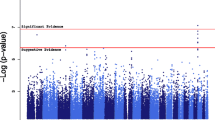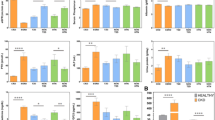Abstract
We recently found in a white population that the genes encoding angiotensin-converting enzyme (ACE, I/D polymorphism), α-adducin (Gly460Trp), and aldosterone synthase (−344C/T) jointly influence renal function. We therefore investigated in a Chinese population the associations between the serum concentrations of creatinine and uric acid and these three genetic polymorphisms. We genotyped 471 ethnic Han Chinese subjects from 125 nuclear families recruited in northern China via random population sampling (75%) and at specialized hypertension clinics (25%). We performed population-based and family-based association analyses using generalized estimating equations (GEE) and quantitative transmission disequilibrium test (QTDT), respectively, while controlling for covariables. The participants were 39.7 years old and included 235 women (49.9%). The blood pressure measured at the subjects’ homes averaged 126/80 mmHg. Mean values were 71 µmol/l for serum creatinine, 111 ml min−1 1.73 m−2 for calculated creatinine clearance, and 236 µmol/l for serum uric acid. With adjustment for covariables, GEE analyses of single genes demonstrated that serum uric acid, but not serum creatinine, was positively associated with the ACE D allele. Serum uric acid concentrations were 15.8 µmol/l (95% confidence interval 3.3–28.2) and 25.7 µmol/l (11.1–40.2) higher in DD homozygotes than in ID and II subjects, respectively. Further GEE analyses of the three genes combined showed that the association between serum uric acid and the ACE polymorphism was confined to carriers of the α-adducin Gly and/or aldosterone synthase C alleles. Sensitivity analyses in parents and offspring separately as well as QTDT analyses were confirmatory. Among 114 informative offspring carrying the α-adducin Gly allele serum uric acid was significantly and positively associated with the transmission of the ACE D allele (β=20.7 µmol/l). In conclusion, the present study extends our previous findings on the combined effects of the three candidate genes and supports the concept that these genetic polymorphisms jointly influence renal function.



Similar content being viewed by others
Abbreviations
- ACE :
-
Angiotensin-converting enzyme gene
- GEE :
-
Generalized estimating equations
- QTDT :
-
Quantitative transmission disequilibrium test
References
Wang JG, et al (2001) Renal function in relation to three candidate genes. Am J Kidney Dis 38:1158–1168
Balkestein EJ, et al (2002) Carotid and femoral intima–media thickness in relation to three candidate genes in a Caucasian population. J Hypertens 20:1551–1561
Staessen JA, et al (2001) Effects of three candidate genes on prevalence and incidence of hypertension in a Caucasian population. J Hypertens 19:1349–1358
Balkestein EJ, et al (2001) Carotid and femoral artery stiffness in relation to three candidate genes in a white population. Hypertension 38:1190–1197
Wang JG, Staessen JA (2000) Genetic polymorphisms in the renin-angiotensin system: relevance for susceptibility to cardiovascular disease. Eur J Pharmacol 410:289–302
Matsubara M, et al (2002) Aldosterone synthase gene (CYP11B2) C-334T polymorphism, ambulatory blood pressure and nocturnal decline in blood pressure in the general Japanese population: the Ohasama Study. J Hypertens 19:2179–2184
Sugimoto K, et al (2001) Alpha-adducin Gly460Trp polymorphism is associated with low renin hypertension in younger subjects in the Ohasama Study. J Hypertens 20:1779–1784
He X, et al (2001) α-Adducin gene and essential hypertension in China. Clin Exp Hypertens 23:579–589
Kunz R, et al (1998) Association between the angiotensin-converting enzyme insertion/deletion polymorphism and diabetic nephropathy: a methodologic appraisal and systematic review. J Am Soc Nephrol 9:1653–1663
Brand E, et al (1998) Structural analysis and evaluation of the aldosterone synthase gene in hypertension. Hypertension 32:198–204
Manunta P, et al (1999) Adducin polymorphism affects renal proximal tubule reabsorption in hypertension. Hypertension 33:694–697
Barlassina C, et al (2000) Synergistic effect of α-adducin and ACE genes causes blood pressure changes with body sodium and volume expansion. Kidney Int 57:1083–1090
Johnson RJ, et al (2003) Is there a pathogenetic role for uric acid in hypertension and cardiovascular disease? Hypertension 41:1183–1190
Stolarz K, et al (2003) Host and environmental determinants of heart rate and heart rate variability in four European populations. J Hypertens 21:525–535
Kuznetsova T, et al (2002) Quality control of the blood pressure phenotype in the European Project on Genes in Hypertension. Blood Press Monit 7:215–224
Morgan L, et al (1999) Angiotensin-converting enzyme insertion-deletion polymorphism in normotensive and pre-eclamptic pregnancies. J Hypertens 17:765–768
Alberti KGMM, et al (1998) Definition, diagnosis and classification of diabetes mellitus and its complications. I. Diagnosis and classification of diabetes mellitus. Provisional report of a WHO consultation. Diabet Med 15:539–553
Praetorius E (1949) Enzymatic method for determination of uric acid by ultraviolet spectrophotometry. Scand J Clin Lab Invest 1:222–230
Gehan EA, George SL (1970) Estimation of human body surface area from height and weight. Cancer Chemother Rep 54:225–235
Kvist H, et al (1988) Total and visceral adipose-tissue volumes derived from measurements with computed tomography in adult men and women: predictive equations. Am J Clin Nutr 48:1351–1361
Cockcroft DW, Gault MH (1976) Prediction of creatinine clearance from serum creatinine. Nephron 16:31–41
Livak KJ, et al (1995) Oligonucleotides with fluorescent dyes at opposite ends provide a quenched probe system useful for detecting PCR product and nucleic acid hybridization. PCR Methods Appl 4:357–362
Zeger SL, et al (1988) Models for longitudinal data: a generalized estimating equation approach. Biometrics 44:1049–1060
Abecasis GR, et al (2000) A general test of association for quantitative traits in nuclear families. Am J Hum Genet 66:279–292
Abecasis GR, et al (2001) Association analysis in a variance components framework. Genet Epidemiol 21 [Suppl 1]:S341–S346
Rossi GP, et al (2001) Exclusion of the ACE D/I gene polymorphism as a determinant of endothelial dysfunction. Hypertension 37:293–300
Matsubara M, et al (2002) Angiotensin-converting enzyme I/D polymorphism and hypertension: the Ohasama study. J Hypertens 20:1121–1126
Lee YJ, Tsai JCR (2002) ACE gene insertion/deletion polymorphism associated with 1998 World Health Organization definition of metabolic syndrome in Chinese type 2 diabetic patients. Diabetes Care 25:1002–1008
Yildiz A, et al (2002) The effect of angiotensin converting enzyme gene polymorphism on chronic allograft dysfunction in living donor renal transplant recipients. Clin Transplant 16:173–179
Kario K, et al (1998) Endothelial cell damage and angiotensin-converting enzyme insertion/deletion genotype in elderly hypertensive patients. J Am Coll Cardiol 32:444–450
Rigat B, et al (1990) An insertion/deletion polymorphism in the angiotensin I-converting enzyme gene accounting for half the variance of serum enzyme levels. J Clin Invest 86:1343–1346
Danser AHJ, et al (1995) Angiotensin-converting enzyme in the human heart. Effect of the deletion/insertion polymorphism. Circulation 92:1387–1388
Müller DN, et al (1997) Vascular angiotensin-converting enzyme expression regulates local angiotensin II. Hypertension 29:98–104
Moriwaki Y, et al (2002) Effects of angiotensin II infusion on renal excretion of purine bases and oxypurinol. Metabolism 51:893–895
van der Kleij FGH, et al (2002) Enhanced responses of blood pressure, renal function and aldosterone to angiotensin I in DD genotype are blunted by low sodium intake. J Am Soc Nephrol 13:1025–1033
Messerli FH, et al (1980) Serum uric acid in essential hypertension: an indicator of renal vascular involvement. Ann Intern Med 93:817–821
Curnow KM, et al (1991) The product of the CYP11B2 gene is required for aldosterone biosynthesis in the human adrenal cortex. Mol Endocrinol 5:1513–1522
Clyne CD, et al (1997) Angiotensin II and potassium regulate human CYP11B2 transcription through common cis elements. Mol Endocrinol 11:638–649
Pitt B, et al (1999) The effect of spironolactone on morbidity and mortality in patients with sever heart failure. N Engl J Med 341:709–717
Pitt B, et al (2003) Eplerenone, a selective aldosterone blocker, in patients with left ventricular dysfunction after myocardial infarction. N Engl J Med 348:1309–1321
Lim PO et al. (2002) Variation in the aldosterone synthase (CYP11B2) locus contributes to hypertension in subjects with a raised aldosterone to renin ratio. J Clin Endocrinol Metab 87:4398–4402
Katsuya T, et al (2003) Salt sensitivity of Japanese from the viewpoint of gene polymorphism. Hypertens Res 26:521–525
Wang JG, et al (2001) Prognostic significance of serum creatinine and uric acid in older Chinese patients with isolated systolic hypertension. Hypertension 37:1069–1074
de Leeuw PW, et al (2002) Prognostic significance of renal function in elderly patients with isolated systolic hypertension: results from the Syst-Eur Trial. J Am Soc Nephrol 13:2213–2222
Culleton BF, et al (1999) Prevalence and correlates of elevated serum creatinine levels. The Framingham Heart Study. Arch Intern Med 159:1785–1790
Culleton BF, et al (1999) Serum uric acid and risk for cardiovascular disease and death: the Framingham Heart Study. Ann Intern Med 131:7–13
Freedman DS, et al (1995) Relation of serum uric acid to mortality and ischemic heart disease. The NHANES I Epidemiologic Follow-up Study. Am J Epidemiol 141:637–644
Jones CA, et al (1998) Serum creatinine levels in the US populations: third National Health and Nutrition Exmination Survey. Am J Kidney Dis 32:992–999
Wang JG, Staessen JA (2002) Raised concentrations of serum creatinine and uric acid and the risks of mortality and cardiovascular disease. Cardiovasc Rev Rep 23:393–397
Acknowledgements
The study was supported by a grant (1999) from the Foundation of Janssen Scientific Research Council (Beijing, China) to J.X., the Bilateral Scientific and Technical Collaboration between Flanders and China coordinated by J.A.S. and L.L. (project BIL98/15), and a grant from the Ministero della Sanità (Milan, Italy) to G.B. (RF200-00-49). In 2003 J.G.W was additionally supported by grant BIL02/10. The authors acknowledge the expert assistance of Aiping Niu, Peixiang Zhang, and Zhiling Du (Gaoping City Hospital, Gaoping, Shanxi Province, China) and Sylvia Van Hulle and Renilde Wolfs (Study Coordinating Centre, Leuven, Belgium).
Author information
Authors and Affiliations
Corresponding author
Rights and permissions
About this article
Cite this article
Wang, JG., Liu, L., Zagato, L. et al. Renal function in relation to three candidate genes in a Chinese population. J Mol Med 82, 715–722 (2004). https://doi.org/10.1007/s00109-004-0574-8
Received:
Accepted:
Published:
Issue Date:
DOI: https://doi.org/10.1007/s00109-004-0574-8




